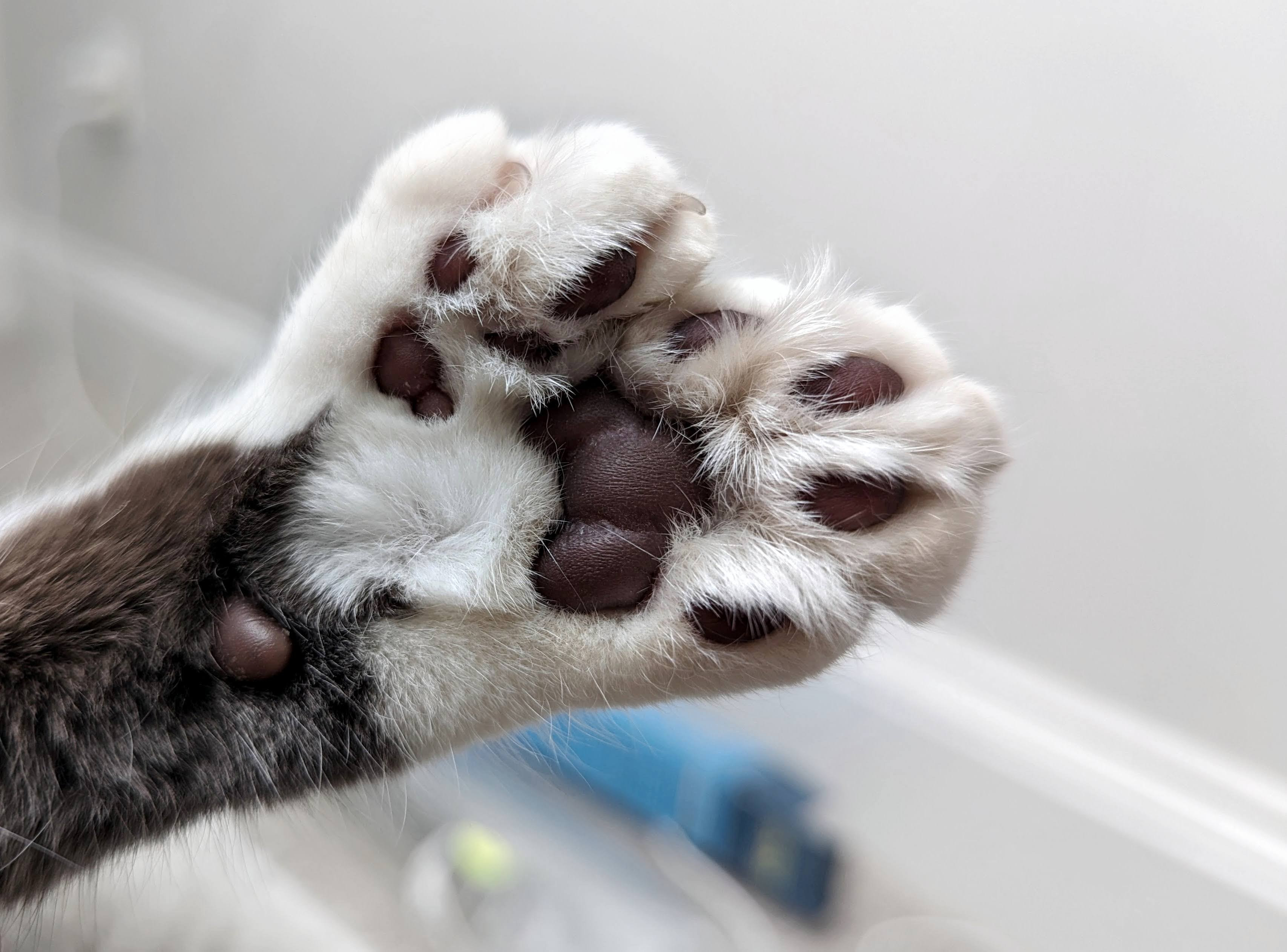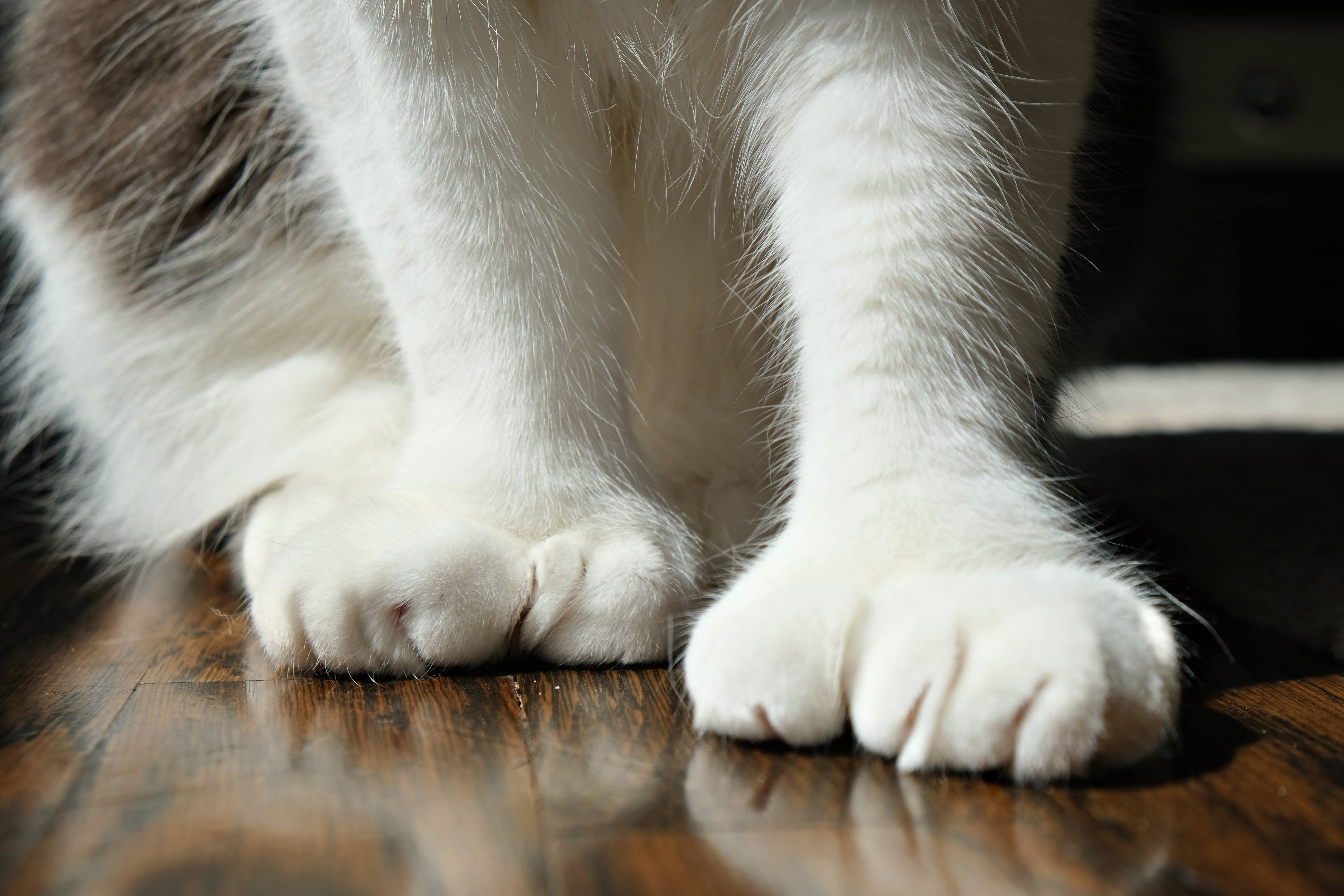If you’re captivated by the charm of cat paws, you’re likely to be intrigued by Mitten Footed Cats. These unique felines, also known as polydactyl cats, Hemingway cats, or cats with thumbs, are born with more toes than the average kitty. The term “polydactyl” itself means “many digits,” perfectly describing this fascinating genetic trait.
But what causes this adorable anomaly? How many toes can a mitten footed cat actually have? Let’s delve into the world of polydactyl cats with insights from veterinary experts, Dr. Anita Patel, DVM, Area Medical Director at IndeVets, and Dr. Alejandro R. Caos, DVM, a small-animal veterinarian at The Vets.
 black and white cat paw with extra toes
black and white cat paw with extra toes
Understanding the Toes of a Mitten Footed Cat
Typically, a cat has 18 toes: five on each front paw and four on each back paw. This count includes a dewclaw on each front paw, but not on the back. However, a mitten footed cat, or polydactyl cat, deviates from this norm by having one or more extra toes. Dr. Patel clarifies, “Polydactyly refers to the presence of extra digits, even if it’s just a single additional toe or an extra dewclaw. These extra toes can appear on either the front or hind limbs.”
The most frequent location for these extra digits is on the inside of the paw, known as the pre-axial or thumb side. Less commonly, they might develop on the outside (post-axial or pinky side) or in the middle (meso-axial). Interestingly, the number of extra toes isn’t always symmetrical, meaning one paw might have more toes than the other.
When it comes to the maximum number of toes a cat can have, the record is quite astonishing. An orange tabby named Jake and a cat from Minnesota named Paws share the Guinness World Record for the most toes on a cat. Both of these remarkable felines boast seven digits on each paw, totaling an incredible 28 toes!
The Genetics Behind Mitten Paws
The reason behind mitten footed cats lies in their genes. Dr. Patel explains that genetics play a significant role in polydactylism. It’s an autosomal dominant trait, meaning only one parent needs to carry the gene for polydactyly to pass it on to their kittens. If a polydactyl cat mates with a non-polydactyl cat, each kitten has a 50% chance of inheriting the polydactyl gene and developing extra toes.
However, the exact genetic mechanisms determining the number of extra toes are still complex. Dr. Caos notes, “The genetic basis of polydactylism is complex. It’s an autosomal dominant trait that has incomplete penetration and variable expression, which contributes to the various toe configurations a polydactyl cat can have.” This explains why some mitten footed cats have just one extra toe, while others have many more.
The origins of polydactyly in cats are not entirely clear, but there’s a theory linking them to early settlers and sailors. Dr. Caos suggests that these seafarers might have brought polydactyl cats to the Americas, possibly valuing them for their larger paws which could have made them better mousers on ships.
While extra toes might seem advantageous for balance, grip, or hunting, Dr. Caos believes polydactyly in cats is more a matter of chance than evolutionary necessity. “Polydactylism is not considered a crucial adaptation for cats’ survival in the wild,” he states. “Most cats, regardless of the number of toes, are well adapted to their natural habitats.”
How Common Are Mitten Footed Cats?
Mitten footed cats are not considered rare. Dr. Caos explains their prevalence: “When a polydactyl cat breeds with a non-polydactyl cat, the offspring have a 50% chance of inheriting the polydactyl gene.” This 50% inheritance rate contributes to their continued presence in cat populations. If both parents are polydactyl, the likelihood of their kittens inheriting the trait increases further.
The most common form of polydactyly involves just one or two extra toes on the front paws, giving them the appearance of mittens or thumbs. Cats with significantly more extra toes, like the record-holders Jake and Paws, are less common and considered more unusual.
Breeds Known for Mitten Paws
 white cat paws with thumbs
white cat paws with thumbs
While any cat can be born with extra toes due to genetics, certain breeds are more predisposed to polydactylism. The Maine Coon and Pixiebob breeds are most commonly associated with mitten paws. Dr. Caos mentions, “Maine Coon cats are known for their large size and tufted ears, and the presence of extra toes adds to their unique appearance.”
You might also hear the term “American Polydactyl,” but it’s important to note that this isn’t a recognized breed. Instead, it refers to cats descended from polydactyl cats originating in Key West, Florida. The famous author Ernest Hemingway, who resided in Key West, owned a six-toed cat named Snow White. Snow White and her descendants, carrying the polydactyl gene, thrived at Hemingway’s estate. Today, Hemingway’s former residence is a museum and home to over 60 polydactyl cats, often affectionately called “Hemingway cats.”
Caring for a Mitten Footed Cat
Caring for a mitten footed cat is generally similar to caring for any other cat. However, their extra toes do bring a few specific considerations:
Nail Care
Mitten footed cats have more nails, some of which might not make contact with the ground. This increases their risk of nail overgrowth. Overgrown nails can cause discomfort, infection, and may get caught on furniture or carpets. Regular nail trimming is crucial to prevent these issues.
Paw Hygiene
Dr. Caos points out, “Extra toes in polydactyl cats means there may be additional spaces between the toes where dirt, debris, or litter can accumulate.” Regularly inspect your mitten footed cat’s paws and gently wipe them clean as needed to maintain good hygiene.
Mobility and Adaptation
Most mitten footed cats don’t experience mobility problems due to their extra toes. However, if your cat has particularly large or unusual toe formations, it’s wise to monitor their movement. They should be able to walk, run, and jump comfortably without any signs of pain.
Dr. Caos advises, “If you notice any limping, favoring of certain paws, or changes in mobility, it’s best to consult a veterinarian for further evaluation.” In rare cases where extra toes cause problems, surgical removal might be considered.
In conclusion, mitten footed cats are a delightful example of genetic diversity in felines. Their extra toes add to their charm and uniqueness, making them even more endearing to cat lovers. With just a few extra considerations for nail and paw care, these special cats make wonderful companions.
